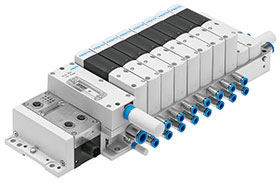

Greater speed in all entrepreneurial processes and a broader range of options for the end consumer are the two key requirements that globalised markets have placed on manufacturing companies. Digitalisation offers the necessary key technologies to meet these two requirements. In addition, information and communication technologies are merging with classical industrial mechanics to generate cyber-physical systems. Festo is adapting to these developments through organisational units that stress the significance of digitalisation.
Digitalisation is an immense task
Successfully providing the growing world population with innovative products can only be ensured by a highly automated manufacturing world. Consumer needs in the global markets differ in accordance with their state of development and expectations. “Digitalisation will accelerate processes within Festo so that we can help our customers efficiently and quickly,” said Dr Ansgar Kriwet, member of the management board at Festo. “Digitally extended products from Festo accelerate our customer processes from the machinery design process right down to service.”
The increase in the customer’s need for customised products places heavy demands on the flexibility of production environments, since consumers want to design and configure products for themselves from wearables such as watches or glasses to cars, personalised dispensing of medicines and self-designed pasta. This can all be made possible by digitalisation.
Evolution of standard products
The core product range for high-quantity series production is of great importance, since success can only be achieved through good relationships with customers. Kriwet elaborates, “Reduced manufacturing costs and the preservation of resources are innovations that generate lasting value. Festo is therefore focusing its innovative power on the development of new products for the rapid and simplified manufacturing of bulk goods. In addition, Festo is advancing digital penetration within the company to benefit from the advantages of Industry 4.0.”
For Festo, evolution also means using investments in infrastructure to secure lasting added value in high-wage countries. Festo manufactures its own products in its own factories, therefore, the company knows exactly how its products perform in everyday use. Automation robots are used to relieve the burden on the human operator and to form collaborative teams.
Revolutionary products for the future
The leap into the future is not only achieved through evolution. For products to survive, new concepts must be introduced in the range. Festo has therefore asked pertinent questions of itself about how these should look: “How can large mechanical products be transferred to intelligent cyber-physical systems? How can we boost our productivity and accelerate the supply chain? What additional benefits and what added-value models will these new products offer our customers in future? How can new tasks be assigned to machinery during regular operation? How can the operator communicate with them and make them even more versatile?”
Festo Motion Terminal
Here is the answer. Just as smartphones turned the mobile communication market on its head a decade ago, the Festo Motion Terminal will do the same for automation technology. The new method of function integration combined with software apps will simplify the entire value chain requiring only one piece of hardware for operating purposes. The terminal apps can replace over 50 individual components. Beneath the unassuming exterior and classic Festo product design, there is technical refinement based on state of the art information technology.
Integrated stroke and pressure sensors together with control via motion apps will open new perspectives for machinery and plant manufacturers. The fusion of mechanics, electronics and software in the Festo Motion Terminal will transform a pneumatic product into a true Industry 4.0 component, and enable flexible production. Changes in pneumatic functions and adaptations to new formats are controlled via apps. The integrated intelligent sensors for control, diagnostics and self-learning tasks will eliminate the need for additional components.
Digitalisation of the customer interface
“Digitalisation enables our customers to design, simulate and operate their production systems as a virtual twin, allowing them to determine in advance whether the modules of their systems will work together as desired,” concluded Kriwet. The complexity of flexible, adaptive production is made controllable through integrated intelligence and the data acquired during operation provides new insight into processes and machine conditions.”
For more information contact Ntando Ndokweni, Festo, +27 11 971 5535, [email protected], www.festo.com
| Email: | [email protected] |
| www: | www.festo.co.za |
| Articles: | More information and articles about Festo South Africa |
© Technews Publishing (Pty) Ltd | All Rights Reserved